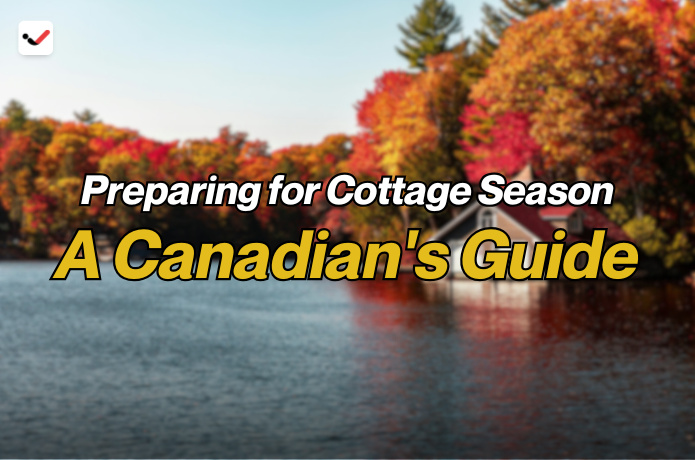Preparing for Cottage Season: A Canadian's Guide
Preparing for Cottage Season: A Canadian's Guide

Cottage season in Canada is a cherished time when families and friends head to their cottages for relaxation, outdoor activities, and enjoying nature. Whether you have a lakeside cabin or a countryside retreat, preparing your cottage for the season is crucial for ensuring a comfortable and safe stay. The transition from winter to spring brings several tasks to complete, from checking your cottage’s plumbing to getting the lawnmower ready for the season. By tackling these essential steps early, you’ll be able to enjoy a stress-free cottage experience.
In this guide, we’ll cover the key preparations every Canadian cottage owner should consider before the busy summer season kicks off. From inspecting the cottage’s structure to ensuring you have all the necessary supplies, we’ll help you get your cottage ready for guests and outdoor fun. Whether it’s your first time opening the cottage or you’ve been doing it for years, this checklist will help you tackle everything you need to do before heading out to the lake or woods.
1. Check the Cottage’s Structure and Exterior
The first step in preparing your cottage for the season is inspecting the structure and exterior. After months of cold weather, snow, and ice, it’s important to assess any potential damage that could have occurred. Start by checking the roof for missing shingles or leaks, especially around the edges where snow may have piled up during the winter. If you notice any damage, contact a professional to handle necessary repairs before the rain and summer heat make the situation worse.
Next, inspect the foundation and walls for any cracks or gaps. These could be entry points for moisture, pests, or drafts. Seal any visible gaps with caulk or weatherstripping to prevent energy loss and ensure a cozy environment. Check the windows and doors to make sure they open and close smoothly, and clean the windows to allow the spring sunshine to brighten your space. Also, inspect the deck, stairs, and railings for any signs of wear and tear. A fresh coat of deck stain or paint can help protect the wood and give your outdoor space a new look.
2. Plumbing and Water Systems
When opening your cottage after a long winter, it’s important to focus on the plumbing and water systems. In many Canadian cottages, pipes are more susceptible to freezing during the cold months, and thawing them carefully is crucial to avoid burst pipes. Begin by turning on the water supply and checking all faucets for leaks or drips. Run the water in the kitchen, bathrooms, and outdoor faucets to ensure there are no blockages or issues.
Additionally, check the water pressure and test the hot water to make sure everything is functioning properly. If your cottage has a septic system, ensure it is inspected and maintained regularly. You may need to pump the septic tank or check for any signs of overflow. It's also essential to check the water heater for leaks, sediment buildup, or signs of rust. Performing these checks early on can prevent any unpleasant surprises when it’s time to relax and enjoy the cottage.
3. Clean the Interior
Cleaning the interior of your cottage is a top priority before you start enjoying your weekend getaways. Dust and dirt can accumulate during the winter months, so giving the space a thorough cleaning will make your cottage feel fresh and welcoming. Start by vacuuming or sweeping the floors, especially if your cottage has a lot of wood or tile. Don’t forget to clean behind and underneath furniture, where dust tends to collect.
Wipe down countertops, shelves, and tables, paying special attention to areas where moisture might have caused buildup or stains. Consider washing curtains or blinds, and deep clean the kitchen and bathroom areas. Cleaning your cottage early in the season will create a comfortable space and prepare it for the months ahead. This also gives you the chance to check for any mold or mildew buildup that can sometimes occur in cottages due to humidity.
4. Safety Checks
Safety should always be a top priority when preparing your cottage for the season. Start by checking the smoke and carbon monoxide detectors. Replace the batteries and test each one to make sure they are working properly. In addition, ensure that the fire extinguishers are fully charged and accessible in case of an emergency. If you have a fireplace or wood stove, have it cleaned and inspected to ensure there is no buildup of creosote, which could lead to a fire hazard.
Check your cottage’s first-aid kit and replenish any missing items, such as bandages, antiseptics, and pain relievers. If you plan to have guests at the cottage, make sure everyone is aware of emergency exits, fire safety procedures, and the nearest hospital or emergency services. Keeping your cottage well-stocked with safety items is a simple but essential task to ensure everyone has a safe and enjoyable time.
5. Prepare the Outdoors
Your outdoor space is where you’ll likely spend most of your time during cottage season, so it’s important to prepare the yard and surroundings. Start by cleaning up any fallen branches, leaves, or debris that may have accumulated over the winter. This will not only improve the appearance of your yard but also reduce fire hazards and prevent pests from making their way inside.
If you have a lawn, it’s time to get your mower out and check that it’s in good working condition. Sharpen the blades and make sure the engine runs smoothly. You may also need to reseed any bare patches on the lawn to ensure a lush and healthy yard throughout the summer. Consider trimming bushes or trees that have grown too close to the cottage or power lines. Don’t forget to clean your outdoor furniture, and perhaps refresh any cushions or pillows that have been sitting in storage. A little outdoor maintenance goes a long way in ensuring your cottage is ready for relaxing afternoons.
6. Stock Up on Supplies
Before you head to your cottage, it’s important to stock up on all the supplies you’ll need for the season. Make sure the kitchen is fully stocked with the essentials, such as non-perishable foods, cleaning supplies, and extra toiletries. Don’t forget outdoor items like charcoal for the barbecue, firewood for the fire pit, and any fishing or boating equipment you plan to use.
Ensure that you have extra batteries for flashlights and lanterns, especially if your cottage is off the grid. If you plan to enjoy the outdoors, check that you have enough sunscreen, insect repellent, and outdoor gear such as camping chairs and portable coolers. Having everything ready to go will make your cottage trips more convenient and enjoyable.
7. Check for Pests
Cottages, especially those located near lakes or in wooded areas, can attract pests like mosquitoes, ants, or rodents. Before you settle in, check for signs of pests and take necessary steps to prevent them. Check the attic, basement, and storage areas for signs of rodents, and make sure windows and doors are properly sealed. Use natural repellents for mosquitoes and other insects, and consider installing screens on windows and doors to keep pests out.
Preparing for cottage season in Canada requires some effort, but the rewards are worth it. With a bit of preparation, you can ensure that your cottage is safe, comfortable, and ready for relaxation. By checking the structure, plumbing, and safety systems, cleaning the interior, preparing the yard, and stocking up on necessary supplies, you’ll be set for a great season. Whether you’re heading to the lake for a peaceful retreat or hosting a family gathering, taking these steps will help you make the most of your cottage experience.

